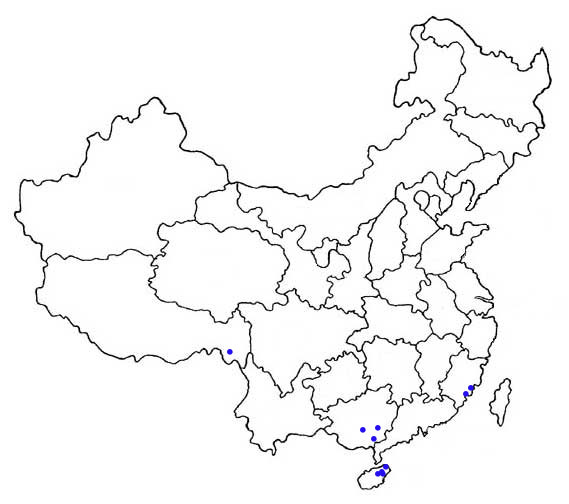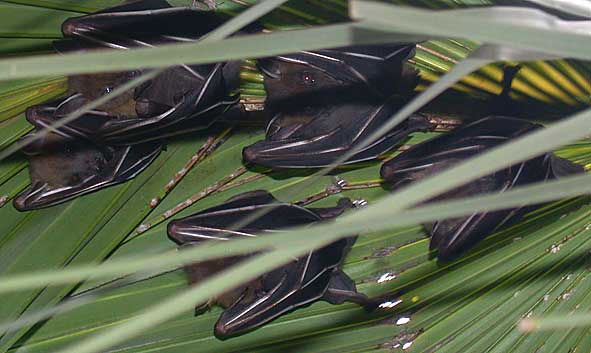Cynopterus sphinx
Greater Short-nosed Fruit Bat
Morphological description Life history Distribution Habitat Roost sites and roosting patterns Emergence and flight pattern Foraging behaviour Echolocation calls Status and protection
Morphological Description
· Dorsal fur is yellowish brown. Ventral fur is more darker than dorsal fur.
· Juveniles are lighter than adults.
· Ears are simple and essentially naked; mocha brown in colour but well defined pale anterior and posterior borders (Bates & Harrison,1997).
· Average forearm length 70.2mm (64-79mm) (Bates & Harrison,1997). We caught one male in Guangdong in September, 2002 with forearm length 72.2mm and weight 63.5g.
Life history
· In some areas of India this species can undergo two pregnancies in a year, and it may breed throughout the year in Sri Lanka. Gestation period estimated at 115-125 days, and young born at 13.5g (Bates & Harrison 1997).
· A tent-making bat with detailed research on mating systems. Some females roost sequentially with different males and with different combinations of females, whereas other females form more stable associations (Storz et al. 2000b). harem size averaged 6.1 adults in the wet season in India, 13.6 adults in the dry season (Storz et al. 2000a). Harems periodically undergo fissions and fusions (Storz et al. 2000a). Variation in male mating success is 9.2 times higher than expected by chance, and results in a ratio of effective population size:census population size of 0.42 (Storz et al. 2001b). Females in harem groups show low levels of relatedness with one another (Storz et al. 2001a).
Distribution
Wide ranging: found from Pakistan, India and Sri Lanka to southern China, Malaysia, Java, Lesser Sunda Island, Borneo and Sulawesi (Bates & Harrison 1997).
The Chinese distribution is shown by dots on the map below (as given by Zhang et al. 1997).

Habitat
· Habitats include agricultural areas, forested regions and parks in cities. (On Hainan Island , it is found at the campus of Hainan Normal University). · Generally, it is found at lower altitudes.
Roost sites and roosting behaviour
· Diurnal roosts include the underside of the leaves of palms; the crevices of banyan, peepul, palm or coconut tree; the flower/fruit clusters of kitul palms; the stems of Ashoka trees and the eaves of houses (Bates & Harrison,1997).
· It can construct elaborate tents by chewing the stems and leaves of plants. Tents can be made by males in 30 to 50 days (Balasingh et al. 1995), and the male then defends the site and attempts to recruit females to it. Fruit clusters can also be modified as tents also (Bhat et al. 1995). Tents are usually occupied by the male bat in the night, while females and young can be present during the day.

Emergence and flight pattern
· Emerges in the early evening, 30 minutes after sunset and forages throughout the night (Bates & Harrison 1997)..
Foraging behaviour
· Forages at forests and fruit farms, using its acute sense of smell to detect fruits.
· The diet consists of a large number of wild and cultivated fruits. The diet mainly consists of fruits (18 species in 11 families), and leaves of two plant species in Xishuangbanna, Yunnan Province. Dietary overlap with Rousettus leschenaultii was relatively high in the rainy season (June - October), while the latter species left the area in the dry season (November-December) when food was scarcer (Tang et al . 2005).
· Several individuals may feed together on the same fruit tree, but visits to flowers appear to be quite solitary.
Echolocation calls
This species does not emit echolocation calls.
Status and protection
· There is no estimation of population size China.
· Greater short-nosed fruit bats are at LR/lc, assessed by the Red List of Threatened Species (IUCN, 2006). they are widely distributed and common in some areas of southern Asia. They are not listed in the Law of the People's Republic of China on the Protection of Wildlife in 1989.
· It causes little damage to orchards. Probably important for seed dispersal. May be persecuted by fruit farmers.
· Possible threats may be habitat loss through development, dams, and deforestation, is also hunted for medicinal purposes (IUCN, 2006).